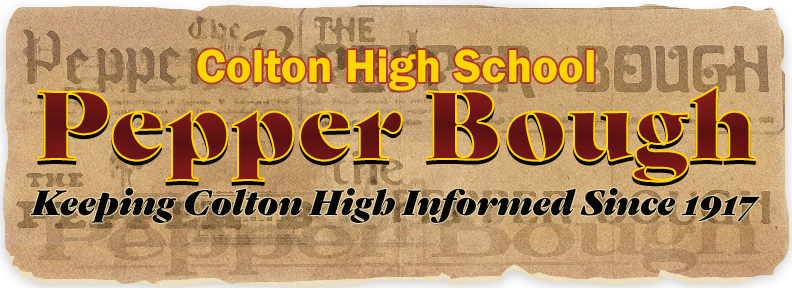Colton Vibe – Songs of the Week – Aug. 29
Mr. Dollins takes the helm from Myles this week to celebrate the anniversary of Gen X legends Pearl Jam’s 1991 album, “Ten”
Pearl Jam celebrates the anniversaries of two of their albums this week, “Ten” and “No Code,” both released on Aug. 27 in different years. This photo is from their show on May 7, 2022 at the Kia Forum in Inglewood, CA.
If you are a “child of the 90s,” you are most likely a Pearl Jam fan.
You may not be a super fan. They may not be your favorite band. But you are probably a fan. And as far as 90s rock bands go, Pearl Jam is easily the one with the greatest longevity. Outside of losing their first three drummers–Dave Krusen, Dave Abruzzesse, and Jack Irons–they have had the steadiest line-up for any band of the era. Contrast with Nirvana, Soundgarden, Smashing Pumpkins, Hole, Alice in Chains, and Stone Temple Pilots, Pearl Jam is one of the only bands to make it out of the 90s fully intact and still playing.
This past weekend, Pearl Jam celebrated the anniversaries of two of their 90s albums, their most popular and their least popular (according to album sales charts), both of which were released on August 27.
Their most popular was “Ten,” released on August 27, 1991. It predated Nirvana’s nuclear “Nevermind” by a month, and didn’t gain traction or radio play until October that year. Once it did, however, “Ten” became a mainstay of rock radio. “Jeremy,” “Even Flow,” “Black,” and “Alive” soundtracked the 90s for Gen X teens looking for their own version of classic rock anthems. Pearl Jam were catapulted to overnight stardom, and the whirlwind of that celebrity led them to embrace and defy that fame in ways both exciting (the recording of “Vitalogy” in 1994) and foolish (the fight against Ticketmaster in 1995).
By 1995, the band was out of sorts. Eddie Vedder, the last band member to join, became the breakout star as the mumblemouthed frontman, leading to a fight for creative control within a band founded by Seattle OGs Jeff Ament and Stone Gossard.
This fight for creative control resulted in the other PJ album celebrating its anniversary, 1996’s “No Code.” Despite be released to mostly positive reviews, the album didn’t have any immediate hit singles like the preceding albums. Instead of anthems like “Animal,” “Daughter,” or “Better Man,” “No Code” featured Indian inspired jams like “In My Tree,” odd poetry slam songs like “I’m Open,” and punk rock speed demons like “Lukin.” The album’s most accessible songs, rocker “Red Mosquito” and ballad “Present Tense” may have been remarkable tracks, but the lyrics were at a remove from the intensely sing-a-long universal appeal of songs like “Rearviewmirror” or “Not For You.”
It was unsurprising that “No Code” was every bit the failure that “Ten” was a success. Within five years, Pearl Jam went from the apex of rock mountain to the valley below.
Yet, “No Code” offered PJ a chance to reflect, helped them heal their band’s collective wounds, and chart the path that has them still playing together and still selling out venues around the world.
Not only that, in hindsight, “No Code” has proven to have legs. While there were no radio-friendly bangers on the record, songs like “Hail, Hail,” “Off He Goes,” and “Lukin” still frequent the band’s setlists.
For me, while I love “Ten” without reservation, especially tracks like “Porch” and “Release,” which never fail to make my heart race like it did when I heard them as a 13-year old kid, “No Code” is the one I return to more often. It’s a mature album, an imperfect album, an album made by a group of friends who didn’t know what their futures held. The songs feel lived in, and express a tired energy that, as I get older, is something extremely relatable. It’s an album that dares to ask “Are our best days behind us? Is this all there is?” Later Pearl Jam records would come to the conclusion that it’s okay if the best days are in the past, but in 1996, only five years removed from being the most popular band in the universe, they sounded unsure of themselves and each other. In 2022, nothing feels more real and more universal than this.
As we honor Pearl Jam this week, let’s look at six tracks from these two albums that still rock.
“Porch” – Ten
Jeff Ament and Stone Gossard, prior to forming Pearl Jam, were part of Mother Love Bone, a Seattle band on the rise until the tragic passing of lead singer Andy Wood, who succumbed to heroin. Most of “Ten” feels like it could have been a Mother Love Bone album, with big classic rock riffs and solos. On “Porch,” we see the influence of Eddie Vedder in full force, as he injects some punk rock into PJ’s DNA. The song begins as a rumbling punk riff before it vaults into the rock stratosphere, and it may be the greatest song on their debut album. When I saw PJ for the first time in 2006 at the Forum, Vedder came out on stage before the opening act to say “hi” to the crowd and play a solo acoustic version of “Porch.” It is still a highlight of my concert going life.
“Red Mosquito” – No Code
“I was bitten . . . must have been the devil.” This paranoid rocker does not have a traditional hook. No riff. Just a beautiful melody and an outro that is one of PJ’s greatest musical moments. The band had just finished recording “Mirror Ball” with Neil Young, and Young’s blustery influence can be felt throughout the song–and the entire album, if we’re honest (“Smile” might as well be an outtake from Young’s “Ragged Glory” sessions).
“Deep” – Ten
The heroin epidemic that tore through the Seattle music scene in the late 80s and 90s wrecked the lives of a number of musicians. Andy Wood, as mentioned earlier, died of an overdose. Kurt Cobain, the generation’s biggest star, committed suicide because he couldn’t kick the junk. The list of musicians who died of overdose includes Layne Staley (Alice in Chains), Kristin Pfaff (Hole), John Baker Saunders (Mad Season), Bradley Nowell (Sublime), Jonathan Melvoin (The Dickies, Smashing Pumpkins), and Mike Starr (Alice in Chains). “Deep” is Pearl Jam’s drug addiction song, and it is hard hitting. Pearl Jam’s own lead guitarist Mike McCready faced his own drug addiction, going in-and-out of sobriety until he committed to it in the early 2000s.
“Off He Goes” – No Code
Eddie Vedder, in an interview with Spin Magazine in August 2001, explained that “Off He Goes,” one of the standout tracks on “No Code” was really about himself. “The song . . . is really about me being a s*** friend,” he told Spin. “I’ll show up and everything’s great and then all of the sudden I’m outta there.” Vedder’s self-reflection gives this melancholy lullaby a hopeful undertone that maybe it doesn’t always have to be this way.
“Even Flow” – Ten
The first half of “Ten” is a monster rock record. Every song–“Once,” “Even Flow,” “Alive, “Why Go?” and “Black”–is a rock radio staple. So, there isn’t much to say about “Even Flow” other than that it rocks. It rocks so hard. Vedder’s mealymouthed vocals are perfect. Mike McCready’s goofy hair metal guitar riffs between verses are perfect. Jeff Ament’s thundering bass is perfect. And that moment when Vedder cries out “YEAH! WOO!” is one of the greatest moments of joy recorded on a rock album. There are some critics who claim Pearl Jam take themselves way too seriously, but I would make them listen to “Even Flow” again as a counterpoint.
“Hail, Hail” – No Code
No one is putting on Pearl Jam for the love songs, especially early Pearl Jam. “Just Breathe” from “Backspacer” is one of their prettiest love songs, but it is an exception to a catalog packed with songs about damaged relationships and insecurity. Look no further than Jeff Ament’s “Hail, Hail,” which is all about navigating through the end of a relationship that has lost all its magic. “Hail, hail the lucky ones/I refer to those in love, yeah.” Maybe the lyrics are about the band struggling with its own relationship, but with a rhythm attack as explosive as this, it doesn’t matter. Break-up never sounded so cool.
Recently, the CHS Publications Department experienced a major theft as over $20,000 in photography equipment was stolen from our studio over Spring Break. This included all cameras. Any amount you donate will help rebuild our program. Thank you!

Jeremiah Dollins is in his third year as adviser for the award-winning Pepper Bough, Colton High School’s official source of news and entertainment....




